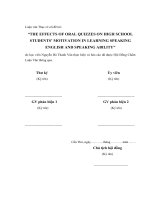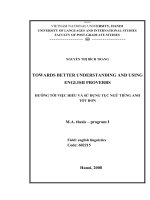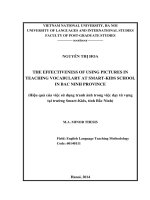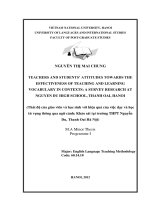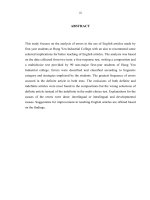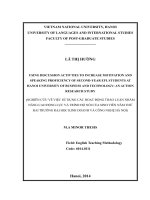High school students’ errors in using English Articles as shown in their written exercises = Những lỗi trong việc sử dụng mạo từ Tiếng Anh trong các bài viết củ
Bạn đang xem bản rút gọn của tài liệu. Xem và tải ngay bản đầy đủ của tài liệu tại đây (2.24 MB, 45 trang )
VIETNAM NATIONAL UNIVERSITY, HANOI
UNIVERSITY OF FOREIGN LANGUAGES AND INTERNATIONAL STUDIES
FACULTY OF POST-GRADUATE STUDIES
------
MAI THI NGAN
M.A. MINOR THESIS
High school students’ errors in using English Articles as
shown in their written exercises
Những lỗi trong việc sử dụng mạo từ Tiếng Anh trong các bài viết của học
sinh Trung học phổ thông.
Field: Methodology
Code: 60.14.10
Hanoi – 2011
VIETNAM NATIONAL UNIVERSITY, HANOI
UNIVERSITY OF FOREIGN LANGUAGES AND INTERNATIONAL STUDIES
FACULTY OF POST-GRADUATE STUDIES
------
MAI THỊ NGÂN
M.A. MINOR THESIS
High school students’ errors in using English Articles as
shown in their written exercises
(Những lỗi trong việc sử dụng mạo từ Tiếng Anh trong các bài tập viết của
học sinh Trung học phổ thông)
Field: Methodology
Code: 60.14.10
Supervisor: Dr. Hà Cẩm Tâm
Hanoi – 2011
i
ABSTRACT
In the process of learning English as a foreign language, Vietnamese high school students
do have to face a lot of problems. English article is considered as one of the most
troublesome problems for every learner because of its complex uses. This MA minor thesis
is an attempt to point out some problems in using English articles of students in writing. It
is hoped that the study would be useful for teachers and students in teaching and learning
English at high schools.
In order to achieve the goal, two data collection instruments were used including exercises
and interviews. While the exercises were designed to collect information reflecting real
problems in using English articles, the interviews following that were developed to find out
the problems in using articles and some possible causes as well.
Results of the study show that Articles in English are complicated words which cause a lot
of difficulties for Vietnamese students. Seven problems: substitution errors, indefinite
article forms, deletion of the articles, problems in using indefinite article with marked and
unmarked plurals, problems in using indefinite article with uncountable nouns, problems in
covering the uses of definite articles and overusing articles were committed in the process
of learning and using Articles. Besides, this research also found out that it is the
interference of mother tongue, avoidance, overgeneralization and the conditions of learning
/ training that have great influence on students’ foreign-language learning.
It is hoped that from this study, teachers and students would be more aware of the
problems to be solved and from the identified problems, they would develop teaching and
learning methods accordingly.
TABLE OF CONTENTS
ii
ABSTRACT……………..………………………………………………………………….i
TABLE OF CONTENTS…………………………………………………………………..ii
LIST OF TABLES…………………………………………………………………………iv
ACKNOWLEDGEMENTS………………………………………………………………...v
PART I: Introduction
1.1. Rationale……………………………………………………………………………… 1
1.2. Aims of the study……………………………………………………………………… 2
1.3. Research question…………...…………….……………………………………………2
1.4. The scope of the study………………………………………………………………… 2
1.5. Methods of the study…………………………………………………………………... 2
1.6. Organization of the study…………………………………………..…………………. 3
PART II: DEVELOPMENT
Chapter 1: Literature review
1.1. Basic concepts………………………………………………………………………….4
1.1.1. Articles in English……………………………………........................................... 4
1.1.2. Classification of English articles...………………………………………..……... 4
1.1.2.1. Indefinite articles………..…..………………………………………………... 4
1.1.2.2. Definite articles. ...................................................................................... …... 6
1.2.3. Articles in noun phrase…………..……………………………………………….... 8
1.3. Review of previous studies ………………………………………………………..….. 8
CHAPTER 2: THE STUDY
2.1. Research questions…………………………………………………………………... 13
2.2. Data collection instruments…………………………………………………………...13
2.2.1. Exercises………………….……………………………………………………….13
2.2.2. Interviews……………….………………………………………………………...14
iii
2.3. The participants……………………………………………………………………….14
2.4. Analytical framework…………………………………………………………………15
2.5. Data analysis…………………………………………………………………………. 16
2.5.1. Uses of articles……………………………………………………………………16
2.5.2. Types of exercise………………………………………………………………….20
2.5.3. Interviews…………………………………………………………………………23
2.6. Discussion………………………………………………………………………….. 23
PART III: Conclusions
3.1. Major findings ………………………………………………………………............28
3.2. Implications for teaching and learning English Articles……………………………...28
3.3. Limitations of the study……………………………………………………….............29
3.4. Suggestions for further studies…………………………………………………. ....... 30
REFERENCES.
Appendix 1……………………………………………………………………………….... .I
EXERCISES……………………………………………………………….………..I
Appendix 2……………………………………………………………………………… IV
STUDENT INTERVIEW…………………………………………………………IV
LIST OF TABLES
Page
iv
Table 1: The Uses of English Articles…………………………………………………. 14
Table 2: Results by the issues/ exercises………………………………………………. 17
Table 3: Results by the types of exercises……………………………………………… 20
CANDIDATE’S STATEMENT
I hereby certify that the thesis entitled:
v
High school students’ errors in using English Articles as shown in their written
exercises
is the result of my research for the Degree of Master of Art at College of Language and
International Studies, Ha Noi National University, and the thesis has not been submitted
for any degree at any other university or tertiary institution.
Signature:
Mai Thi Ngan
ACKNOWLEDGEMENTS
vi
The largest debt of all is to my supervisor, Dr. Ha Cam Tam,
who
has
given
me
much
invaluable
advice
and
careful
instructions since the very beginning and has always been my
frequent
secure
for
many
invaluable
insights.
I
am
also
grateful to her for reading and helping me make the necessary
changes.
I am indebted to all the lecturers of the Post-Graduate
Department, College of Foreign Languages, Vietnam National
University, Hanoi for their valuable teaching and assistance
during my study at the College .
I must in particular thank Assoc. Prof. Dr. Le Hung Tien, the
Head of the Post- Graduate Department, and the lecturer of
Scientific Research for his useful and precious instructions
during the course.
My sincere thanks are due to the students and teachers at
Thach Thanh High School No.3, Thanh Hoa, who have provided me
with the valuable data.
Finally, I am grateful my family and my friends for their
great support and encouragement in the accomplishment of this
study.
1
PART I: INTRODUCTION
1.1. Rationale
English as native language or second language is the most widely used throughout the
world. Since English has become an effective means of international communication and it
can be instrumental to personal and professional success, it has been the first choice of
most Vietnamese learners of foreign languages. But in the process of learning, Vietnamese
learners do have to face a lot of problems. English article is considered as one of the most
troublesome problems for every learner because of its complex uses.
The English articles “a(n), zero, the” are quite difficult to acquire not only for ESL / EFL
learners but also for children learning English as a first language. Articles are believed to
be a source of difficulty for learners (and teachers) of English as a second / foreign
language, especially for those whose native languages do not have articles. English articles
are hardly crucial communication devices, which are supported by the fact that they are
dropped in telegraphic exchanges. They are generally overlooked by learners when
processing language primarily for meaning. According to Pienemann (1998), the difficulty
of the meaning expressed by an article is determined by the novelty and abstractness of the
concept, not to mention learners' changing hypotheses about article usage at different
stages in interlanguage development and the potential influence of the native language
which may further complicate the task.
Articles do not impede understanding, for in oral communication, they are generally
unstressed and almost inaudible. Nevertheless, given the fact that they are among the most
frequently used words in English (Master, 2002), it is significant that students have some
control of their usages. When you learn English articles, you are learning one of the easier
components of this language. But if you want to master articles, one of the first things you
must perfect is your understanding of their nuances. However, if the very concept of
articles does not exist in your native language – as is true of many Asian countries
including Vietnam, then it can be quite a daunting task to learn English articles and use
them appropriately. Most Vietnamese learners defined that the definite (the) and indefinite
(a, an) are presented and the different cases where they are applicable. But many of them
can’t explain why is it correct to say "a horn" and not "an horn"; but "an hour" and not "a
2
hour"; "a unit" and not "an unit"; but “an utterance” and not “a utterance” ... They even
have difficulties in explaining a / the before “dentist” in two following sentences I don’t
like going to the dentist and A dentist is a person who checks your teeth. Or there are
instances where no article must precede a noun, and fixing an article before it can change
the meaning , which confuses students as well. For example, "Clothes are expensive"
implies that all clothes in general are expensive, but "The clothes are expensive" implies
that only the clothes that one is talking about are expensive. …
These questions remain quite problematic for Vietnamese students. Therefore, it is
necessary to carry out this research about problems in using English Articles of students at
High Schools. Hopefully, this study may be of some help to those who are interested in the
topic.
1.2. Aims of the study
This study aims at identifying problems in using English articles in writing by students of
Thach Thanh High School No. 3 and suggesting some possible solutions to overcome the
problems.
1.3. Research question
The study was set up to answer the following question:
What problems in using English Articles do students of Thach Thanh High School No.3
usually encounter in their writing?
1.4. The scope of the study
The reseach will be studied to find out the problems in using both indefinite and definite
articles in writing sentences by students of Thach Thanh High School No.3.
The exercises used in this study were taken from the textbook “Tieng Anh 11 and Tieng
Anh 12 - chuong trinh co ban” and the basic grammar books in which the examples
involved have been examined, described and classified for pedagogical purpose.
1.5. Methods of the study
In order to identify what problems high school students have in using English Articles in
their writings, Quirk’s framework was used to the descriptive statistics for data analysis .
3
1.6. Organization of the study
The study consists of three main parts. Part one, Introduction, includes the rationale, the
aims, the scope, the research question, the methodology and the organization of the study.
Part two includes two chapters. Chapter one provides the theoretical background on
English Articles. A comparison between the definite article and indefinite articles is also
given in this chapter and review of previous studies on using English Articles by learners
of English. Chapter two discusses the data collection instrument, the participants, the
analytical framework and the data analysis including results from the survey exercises and
interviews. Besides, some discussions about the results can also be found in this chapter.
Part three presents the conclusions of the major findings, the implications for learning and
teaching English articles, and suggestions for further research.
4
PART II: DEVELOPMENT
CHAPTER 1: LITERATURE REVIEW
This chapter provides an overview of the theoretical background of the research in
general. It is divided into two main sections. Section 1.1 discusses some basic concepts of
English articles via the definition, classification and usage system of English articles. A
minor comparison between the definite article and indefinite articles is also given in this
chapter. Section 1.2 discusses some previous studies on using English articles by learners
of English.
1.1. Basic concepts
This section begins with a brief overview of articles in English (1.1.1). The classification
including form, uses and omission for each article used in the study are discussed (1.1.2). It
then followed by a brief summary of articles in noun phrases (1.1.3).
1.1.1. Articles in English
According to Erichsen (2005), English articles are somewhat arbitrarily defined as a small
group of determiners that are placed before nouns. Articles standing alone have little
meaning; when used with a noun they can indicate whether the noun refers to a specific
one or ones of its type or whether it refers to its type in general. It means that the English
article is the part of speech used to indicate and specify nouns.
To clarify the definition above, classification and usage system of English articles are
considered in the following section.
1.1.2. Classification of English articles
There are two types of English Articles. They are indefinite and definite articles:
1.1.2.1. Indefinite articles
a. Form: A - An
A is used before a word beginning with a consonant, or a vowel with a consonant sound:
E.g.
a man
a hat
a European
a one-way street
a university
5
An is used before words beginning with a vowel(a, e, i, o, u) or words beginning with a
mute h.
E.g.
an apple
an island
an uncle
an egg
an hour
an X
an onion
..
- Or individual letters spoken with a vowel sound.
E.g.
an MP
an SOS
- A / An is the same for all genders.
E.g.
a man
a woman
an actor
an actress
a table …
b. Uses of A / An
- Before a singular noun which is countable (i.e. of which there is more than one) when it
is mentioned for the first time and represents no particular person or thing.
E.g.
They live in a flat.
He bought an ice-cream.
- Before a singular countable noun which is used as an example of a class of things:
E.g.
A car must be insured.
(= All cars / Any car must be insured.)
- With a noun complement. This includes names of professions:
E.g.
She’ll be a dancer.
- In certain expressions of quantity:
E.g.
a lot of
a great many
a great deal of
a couple
a dozen
- With certain numbers:
E.g.
a hundred
a thousand
a half kilo of…
- In expressions of price, speed, ratio…
E.g.
four times a day
sixty kilometers an hour
…
- In exclamations before singular, countable nouns:
E.g.
Such a long queue!
What a pretty girl!
c. Omission of A / An
A / An is omitted:
- Before plural nouns. A / An has no plural form. So the plural of “a dog” is “dogs”, and
“an egg” is “eggs”.
- Before uncountable nouns.
- Before names of meals, except when these are preceded by an adjective:
E.g.
We have breakfast at eight.
But
He gave us a good breakfast.
6
1.1.2.2. Definite articles:
a. Form: The
The is the same for singular and plural and for all genders:
E.g.
the boy
the girl
the day
the boys
the girls
the days
…
b. Uses of The
- When the object or group of objects is unique or considered to be unique:
E.g.
the earth
the sea
the sky
the equator
- Before a noun which has become definite as a result of being mentioned a second time.
E.g.
His car truct a tree; you can still see the mark on the tree.
- Before a noun made definite by the addition of a phrase or clause:
E.g.
The girl in blue
The man with the banner
The boy that I met
The place where I meet him
- Before a noun which by reason of locality can represent only one particular thing:
E.g.
Ann is in the garden
(the garden of this house).
Please pass the wine, please.
(the wine on the table).
- Before superlative and first, second… used as adjectives or pronouns, and only:
E.g.
The first week
the best day
the only way the second part
- Before certain proper names of seas, rivers, group of islands, chains of mountains, plural
names of countries, deserts, regions:
E.g.
The Atlantic
The Netherlands
The Thames
The Sahara
The Azores
The Alps
The Strand
The Sudan
- Before other proper names consisting of adjective + noun or noun + of + noun:
E.g.
The National gallery
The Tower of London
- The + singular noun can represent a class of animals or things:
E.g.
The whale is in danger of becoming extinct.
The can be used before a member of a certain group of people:
E.g.
The small shopkeeper is finding life increasingly difficult.
- The + adjective represents a class of persons.
E.g.
The old = old people in general
The rich = rich people in general.
- The with names of people has a very limited use. The + plural surname can be used to
mean ‘the…..family’.
E.g.
The Smiths = Mr. and Mrs. Smiths (and children).
7
c. Omission of The
The definite article (the) is not used:
- Before names of people.
- Before abstract nouns except when they are used in a particular sense
E.g.
Men fear death
(But: The death of Prime Minister left his party without a leader.)
- After a noun in the possessive case, or a possessive adjective
E.g.
The boy’s uncle
= the uncle of the boy.
It’s my (blue) book
= the (blue) book is mine.
- Before names of meals
E.g.
The Scots have porridge for breakfast
(But: The wedding breakfast was held in her family’s house.)
- Before names of games
E.g.
He plays gold.
1.1.3. Articles in Noun Phrase
Singular count nouns in English always follow one of the articles "a, an, the", while noncount nouns require the "zero" article or a definite article "the". Quirk and Greenbaum
(1973) set up two different systems of article use depending on the type of reference:
DEFINITE
The tiger
SPECIFIC
INDEFINITE
A tiger
The ink
REFERENCE
The tiger
GENERIC
The tiger
REFERENCE
A tiger
(Some) ink
(some) tigers
Ink
Tigers
With definite specific reference, the definite article is used for all noun classes:
E.g.
Where is the pen I bought?
Where is the ink I bought?
Where are the pens I bought?
8
With indefinite specific reference, singular count nouns take the indefinite article a(n),
while non-count and plural count nouns take zero article or unstressed some (any) in nonassertive contexts.
E.g.
I want a pen / some pens / some ink.
I don’t want a pen / any pens / any ink.
1.2. Review of previous studies.
The problems encountered by English learners whose mother tongue does not have an
article system have been researched extensively. A detailed account is given of the
commonest types of errors, classified according to the misuse of each article. It is found
that the commonest errors involve misuse of the definite article for generic reference.
Master (2002) showed that the is the commonest word in English and a in the top five and
together the and a make up 8.5% of all English text (Berry, 1993). Scott and Tucker (1974)
found article errors among the top four types of error among high school graduate. But
many studies do not all classify errors in the same way or count the same things; Batainehs
(2005) only looks at a, for example. Scott and Tucker (1974) and Bataineh (2005) do not
tally accurate use instances so an overall success or failure rate for each article cannot
be calculated. In Scott and Tucker’s (1974) and Bataineh’s (2005) data, “Ø-for-a” is
the more frequent error subtype; in Kharma’s data “the-for-a” is slightly more
frequent.
Kharmas (1981) data is the most detailed about types of article use; he identified 5 types of
use for the and a and 3 for Ø. Of the ten most common mistakes in his cloze test six
are categorized as instances of generic or general use (3 where the correct answer
was Ø, and 3 where it was a), and 3 as misrenderings of idiomatic phrases. (e.g. for an
example).
In a range of idiomatic uses learners are likely to “reinstate” definite articles omitted in
English (e.g. I went to the bed).
9
Kharma and Hajjaj (1997) add four other likely transfer problems:
Problems
Examples
Non-ellipsis of articles in compound noun
The salt and the pepper [ pepper]
phrases
use of the definite article in generic plural
The horses [ Horses] are useful
noun phrases
animals
use of the definite article for abstract nouns
All men fear the death [ death]
use of the definite article for mass nouns
The milk [Milk] is nutritious to the
body
Farghal and al-Zou'bi (2004) compared three different English translations of the
Koran and showed evidence that none of the translators has fully acquired how
English handles generic reference, using the instead of Ø with generic plural noun
phrases (e.g. The lions are ferocious animals) and using the in generic singular noun
phrases where English would require a (e.g. The wolf ate him for A wolf ate him).
In terms of the role of transfer in causing errors, Scott and Tucker (1974) attributed half
their subjects article errors to transfer, and Kharma (1981) attributed the majority of
his subjects
errors to transfer but adds the compounding effect of “inadequate
instruction”. Bataineh (2005) considered transfer responsible only for “Ø-for-a” errors
and even then only as a possibility, citing overgeneralization, training transfer, learning
and communication strategies as other possible causes.
A frequent and persistent grammatical problem many EFL teachers encounter in
schools, colleges and universities is the misuse or omission of the articles a, an
and the in both written and spoken language. This is a serious linguistic problem for
several reasons:
- Articles occur frequently … The American Heritage Word Frequency Book
(Carroll et al, 1971) lists the as the most commonly used word in the English language,
and a as the fourth.
10
- Misuse of articles can lead to serious errors because of resulting meaning variations,
since ‘the distinction they mark is obligatory’ (Matthews, 1997, p.26). Master (1994,
p.230) notes that the need for accurate use of articles increases with writing, since
readers do not have the luxury of extralinguistic clues to help understanding.
- The problem is persistent, even to higher-level learners. Claire and Greenwood,
(1988, cover page) state that… Articles “are often the last grammatical item that
distinguishes the native-speaker of English from the foreign-born speaker ”.
There is a wide range of complications in tackling a language target of this sort. The
question of the use of a and the, far from being an isolated point of language, is intimately
tied into a variety of closely-linked language questions, such as pronoun use, plurals,
countable and uncountable nouns, zero article, language ‘chunks’ which include articles,
and those ‘rules’ which seem to be clear cut, such as naming hotels and rivers. In addition,
there seem to be numerous anomalies, or sub-rules which complicate the issue for both
student and teacher.
E.g.
We go to the bathroom.
( but not to the bed.)
We also go to work.
( but not to office.)
Students are likely to be baffled when British people say that someone is ‘in
hospital’, meaning they have been admitted, but someone went to ‘the hospital’ to visit a
sick person.
Analyzing the errors made by Taiwanese EFL college students, Li-Ling Chen (2006)
showed that another grammatical error that is frequently found in Taiwanese EFL students'
compositions is the misuse of English articles. Chen (2000) considered that English articles
could be one of the most difficult grammatical parts for Taiwanese EFL students as there is
not an equivalent syntactical device to the English article system. Master (1988) further
indicated that beginning level EFL learners tend to be more interfered by such a linguistic
difference between Mandarin and English.
In a few matters of form, Trunk, Jr. (1918) showed the problem in using articles is that
omitting initial a or the from titles when you place the possessive before them for the titles
of literary works.
11
E.g. The Iliad
The Odyssey
To a Skylark
…
In addition, some researchers employed error analysis to examine the error types in
Taiwanese EFL students' English writings (Horney, 1998; Kao, 1999; Lin, 2002; Tseng,
1980; Ying, 1987). Horney (1998) investigated compositions written by 80 Taiwanese EFL
students. The results revealed that errors in the use of articles had the highest percentage
(11%).
In the book “Common mistakes at the certificate…and how to avoid them”. Susanne
Tayfoor (2004) showed that we use the to talk about a particular thing / person when the
speaker and listener know which one we are referring to. We use a, an to refer to
something for the first time, and the to refer it again. And then he showed four cases we
don’t use the. Those often causes problems to students at High School.
We don’t usually use the in four following cases:
- to talk about people / things in general
- for countries, mountains or seas, unless it is a group or states or islands:
- with meals (E.g. have breakfast; eat lunch; finish dinner)
- with certain common daily routines (E.g. Go to work/ school, be at home; be at work/
school; go by bus/ car; go home; watch TV)
( pp. 50-51)
In sum, there were many problems for students in using the English articles in the writings,
but within a limited time, results of the study will be taken based on the following usages;
the uses of articles including errors in using definite article for specific things, errors in
using articles for definite or indefinite meaning, errors in misusing articles (as in using the
for generic plural or uncountable noun phrases, abstract nouns, mass nouns, using the
instead of Ø with generic plural noun phrases, using the in generic singular noun phrases
where English would require a, using indefinite article for specific singular noun phrases,
using Ø instead of the with the only one of something, not using the for classes of people,
universally unique items, items unique to a situation, diectically obvious items, items of
anaphoric reference, items defined by a relative clause, superlatives, not using the to talk
about a particular thing / person, when the speaker and listener know which one we are
referring to, not using the to talk about people/ things in general, using a / an for
12
uncountable nouns, not using a, an to refer to something for the first time, and the to refer
it again…).
The types of exercises including filling in, multiple choice and correction exercise and the
interviews were also mentioned.
13
CHAPTER 2: THE STUDY
This chapter outlines the research question, data collection instruments, the participants
analytical framework, data analysis and discussion. Section 2.1 discusses research question
while section 2.2 presents two data collection instruments. Section 2.3 discusses
participants joined in interviewing and doing exercises. Section 2.4 presents a brief
overview of the articles’ usages, it’s used to analyze the data in section 2.5. Section 2.6
discusses the data of the study.
2.1. Research question
In order to achieve the aims of the study the research question below will be addressed:
- What problems in using English Articles do students of Thach Thanh High School
No.3 usually encounter in their writing?
2.2. Data collection instruments
Section 2.2 provides an overview of data collection instruments. Data was collected via
exercises and interviews.
2.2.1. Exercises
All exercises were designed based on the uses of articles and these types of exercises: filling
in the blanks with the suitable article, multiple choice and mistake correction.
These exercises were designed to students in both close-ended and open-ended questions.
Four main exercises (see Appendix 1) which were taken from the textbook “Tieng Anh 11
and Tieng Anh 12 - chuong trinh co ban” and the basic grammar books, were used to
collect data .
A set of exercises was designed in the survey which were delivered to 100 students and
required to do in class during one 45-minute period in order to find out what problems are
raised in using articles and why it is difficult for them. The survey consists of three
common types of exercises, with which students have already been familiar with during
their learning process of any English language items. These exercises, of course, focus on
the relevant matter, the usages of English articles.
14
Exercise 1 including 15 questions was designed to distinguish these issues: a vs. an, the
vs. Ø, a vs. the by circling the best answer. Exercise 2 including 10 questions was about
the uses of articles by the filling-in exercise. The same number of questions was also
pointed in exercise 3 but in different type of exercise: multiple-choice. These exercises
aimed at checking the uses of articles, following that problems in using English Articles
were found. Besides, exercise 4 was designed as the rewritten exercise to check the
positions as well as the uses of English Articles, which answer the research question about
the problems in using English Articles of students at High School.
2.2.2. Interviews
Like exercises, the interviews were designed for the students (see Appendix 2) to have an
insight into the answers collected throughout the exercises. However, unlike the exercises
which included both the close-ended and open-ended questions, the interviews comprised
of only open-ended ones and belonged to semi-structured type. This type of interview was
chosen because it was believed to get more information of problems which students
usually made in using English Articles.
The students were asked about the uses of articles, the difficulties they often encounter in
using articles. The information collected helped a lot in answering the research question.
The last question which is about their suggestions, would help a lot in the final chapter of
this research about some suggestions for better teaching of English articles. This interview
was ensured to take place in a very informal and comfortable atmosphere so that the
students can share their opinion openly and freely.
2.3. The participants
100 students at random from A1 to A5 (including 52 male and 48 female) at Thach Thanh
High School No.3 in Thanh Hoa took part in the survey. The students aged from 17 to 19
are learning in 12th form. Most of them have been learning English since they started high
junior school, i.e. they have been learning English for at least more than 6 years.
In the total of 100 students above, 20 students were chosen (including 40% male and 60%
female), all of whom were between 17 and 19 years of age and got marked 3 or 5,7,9 in
their exercise papers (5 students (25%) per each mark), were selected for the interview.
15
2.4. Analytical framework
The following table presents a brief overview of English articles’ usages. It’s used as the
analytical framework to analyze the data:
Table 1. The Uses of English Articles.
Articles
Uses
- A is used before a word beginning with a consonant. An before words
beginning with a vowel or a mute h.
- Before a singular noun which is countable (i.e. of which there is more than
A / An
one) when it is mentioned for the first time and represents no particular
person or thing.
- Before a singular countable noun which is used as an example of a class of
things.
- With a noun complement. This includes names of professions.
-In certain expressions of quantity examples.
- When the object / group of objects is unique or considered to be unique.
- Before a noun which has become definite as a result of being mentioned a
second time.
The
- Before a noun made definite by the addition of a phrase or clause.
- Before a noun which by reason of locality can represent only one particular
thing.
- Before superlative and first, second… used as adjectives or pronouns, and
only.
- Before a member of a certain group of people.
- Before certain proper names of seas, rivers, group of islands, chains of
mountains, plural names of countries, deserts, regions…
- Before other proper names consisting of adjective + noun or noun + of +
noun.
16
- The + adjective meaning as a class of persons.
- The + plural surname can be used to mean ‘the…..family’.
- Before names of meals (except when these are preceded by an adjective).
- Before names of people.
Ø
- Before abstract nouns except when they are used in a particular sense.
- Before a noun in the possessive case, or a possessive adjective.
- Before names of games.
2.5. Data Analysis
In this section, results of the data analysis will be presented in the following order: Section
2.5.1 discusses the problems in using articles by issues: “a vs. an”, “the vs. Ø”, “the uses
of the” and “the vs. a”. Section 2.5.2 presents the problems in using articles according to
three types of exercises. The last section 2.5.3 discusses the results of interview regarding
students’ assessment on the uses of articles.
Section 2.5.1 discusses the problems in using articles by four issues (a vs. an, the vs. Ø,
the uses of the and the vs. a). In the total of 40 questions in exercise paper, there are 10
questions related to a vs. an (5 of exercise 1, questions 1,4,5,9 exercise 2, question 5
exercise 4), 11 questions related to the vs. Ø (5 of exercise 1, questions 2,10 exercise 2,
questions 1,7,9 exercise 3 and question 1 exercise 4), 8 questions about the uses of definite
articles( including questions 7,8 exercise 2, questions 5,6,8,10 exercise 3 and questions 2,4
exercise 4) and 11 other questions about the distinction between the and a.
2.5.1. Uses of articles
The results by issues for each exercise based on the total number of answers of 100
students after marking their exercise papers are shown in the table 2:
17
Table 2: Results by issues and exercises (N = 100)
Issue
a vs. an
The vs. Ø
The
the vs. a
T
W
T
W
T
W
T
W
1
500
135
500
219
0
0
500
152
2
400
154
200
57
200
104
200
67
3
0
0
300
131
400
243
300
147
4
100
77
100
51
200
105
100
37
T
1000
366
1100
458
800
452
1100
403
Exercise
P
36.6%
41.6%
56.5%
36.6%
T = Total number of answers
W = Wrong answers
P = Percentage of wrong answers
As can seen from table 2, the highest error rate occurred within the use of definite article,
with 452 wrong answers in the total of 800 answers, an error rate of 56.5%. This result
shows that students have most serious problem with the use of the definite article. Error in
using the/Ø is the second highest error in this table, with 458 wrong answers in the total of
1100 answers or an error rate of 41.6%. The result shows that misusing the for Ø and vice
versa was prevalent. The third highest error rates occurred by the distinction between a and
an, the and a, with the same error rate of 36.6%.
First of all, considering the use of a vs. an , results show that in the total of 1000 answers
there are 366 wrong answers, in which 135 errors were found from 5 questions in exercise
1, 154 errors were detected from 4 questions in exercise 2 and 77 errors were found in
exercise 4. Of these errors, errors in using a instead of an or vice versa for special cases
(such as, errors in using a before words beginning with a mute h or using an before words
beginning with u spelt in vowel sound) are the highest. As in question no. 5 of exercise 1
“Does wearing a uniform / an uniform have a special meaning to students?”, eighty-two
out of a hundred students circled “an uniform” instead of “a uniform”. In this case, “a
uniform” is correct answer because “u” is spelt in vowel sound [ju:]. It seems that
students applied the rule (using an before noun beginning with a vowel u) for all cases.


